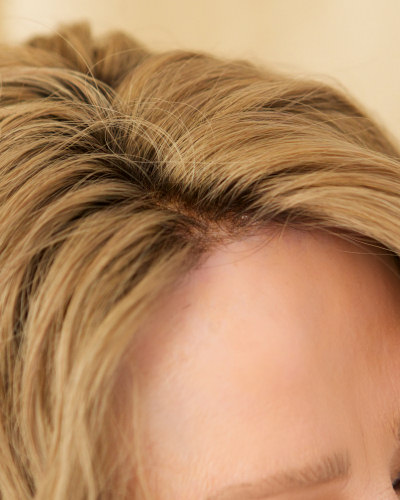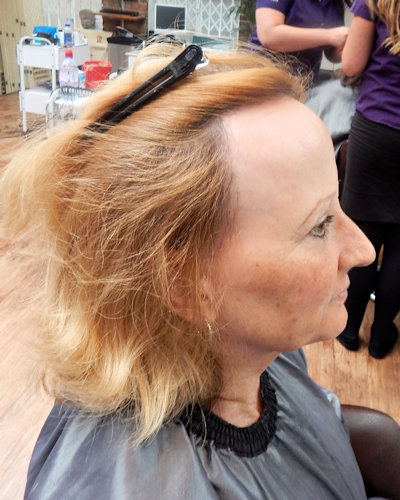Frontal Fibrosing Alopecia
Frontal Fibrosing Alopecia, discovered only recently in hair loss terms in 1994, is also known as Scarring Alopecia or Cicatricial Alopecia and has a distinctive clinical pattern of hair loss characterised by progressive recession of the hairline at the front and sides of the scalp.
Disguising the Effects using the Integrated Intralace System
The Intralace System™ effectively disguises the areas of hair loss and when used in conjunction with our revolutionary Natural Hair Line Parting and Natural Hair Line Sides then we can recreate the clients hair line and the system is worn 24/7.
Clients can wash, brush and care for their new hair just like it was their own. It is undetectable to the human eye. The Intralace System® can be integrated with the clients’ own natural hair immediately behind the affected areas and we use sections of a medical grade tape to secure the immediate front hair line and sides. The system is semi-permanent and unlike a wig it does not need to be removed at night, it becomes part of you and is a very natural looking and manageable way to disguise the effects of FFA.
This client with Frontal Fibrosing Alopecia uses our Intralace System® with the Natural Hair Line Option. As with all of our clients, this lady washes and brushes her new hair as her own.

Melanie's alternative look with a fringe
Likely Causes and treatment for FFA
Scientists believe that Frontal Fibrosing Alopecia is a direct result of the immune system attacking an individual’s hair follicles, which causes inflammation. This in turn damages the follicle. As the majority of women with FFA have been through the menopause, it is thought that there may be a hormonal link. Frontal fibrosing alopecia is thought to be a variant of lichen planopilaris.
When choosing a treatment it is important to remember that FFA is an irreversible process with a slow course although in some cases it may stabilise after a few years. Currently there is no clearly defined line of treatment. Topical treatments such as steroid gels or creams may be prescribed and a course of antibiotics may help reduce inflammation. Please consult your doctor.

Close-up of the natural hair line
Dr Vicky Joliffe describes FFA
‘Frontal Fibrosing Alopecia is a relatively newly described cause of hair loss which has only been recognised over the past 15-20 years.the cause is not known but research worldwide is currently being undertaken to investigate any precipitating causes.
It typically affects peri-menopausal or menopausal women and presents usually with the frontal margin hairline slowly moving backwards. The eyebrows may also become sparser or even disappear. There may be some redness and scaling around the emerging hairs.
Treatment may include anti-inflammatory medication, and/or steroid injections.
Lichen planopilaris is a rare cause of scarring hair loss typically associated with scalp itch or soreness. Redness and scaling of the scalp are common features.
Diagnosis requires a scalp biopsy for confirmation and treatment by a dermatologist is required’
Read Jenny’s Story
Jenny had suffered gradual receding of her hairline over many years and had lost much of her confidence and self-esteem because of it.
After reading about our approach in a magazine article she decided to come and see us.
Read her story about living with FFA

Frequently Asked Questions about Alopecia Areata
What is Alopecia Areata?
Alopecia Areata is an autoimmune, non-scarring hair-loss condition where the immune system temporarily targets hair follicles, creating smooth, round patches of loss. It can also affect brows, lashes, and other body hair. A dermatologist can confirm diagnosis; we provide cosmetic solutions and day-to-day support.
What are common Alopecia Symptoms?
Typical Alopecia Symptoms include sudden patchy hair loss, short “exclamation-point” hairs at patch edges, and sometimes nail pitting or ridging. Some people notice mild tingling or itch before shedding begins. Symptoms may come and go—periods of shedding can be followed by stability or regrowth.
What are the most frequent Alopecia Causes?
Alopecia Causes are rooted in immune dysregulation and genetics. Flares can coincide with illness or stress, but not always. Daily hair care, washing, coloring, ponytails, or hats do not cause Alopecia Areata, and it isn’t contagious.
What does Alopecia Treatment usually involve?
Alopecia Treatment is individualized and led by a dermatologist. Small patches may be treated with local steroid injections or topicals; more extensive loss may involve systemic therapies. Because timelines vary, many clients also choose cosmetic coverage to restore appearance and confidence right away.
What should I know about Alopecia Regrowth?
Alopecia Regrowth is common but unpredictable. Fine, light “vellus” hairs often appear first and can darken and thicken over time. Regrowth can occur while you’re receiving treatment—or even without treatment—and future flare-ups are possible, so a flexible plan helps.
How fast can Alopecia Regrowth happen, and is it permanent?
Regrowth can begin within weeks to months, but the pace varies. Because Alopecia Areata can relapse, it’s best to think in terms of ongoing management rather than a permanent cure. Consistent medical follow-up plus cosmetic maintenance keeps you prepared.
Could stress be one of the Alopecia Causes?
Stress alone doesn’t “cause” Alopecia Areata, but it may coincide with flares for some people. Supportive routines—sleep, movement, and counseling—won’t cure AA, yet they can help your wellbeing during Alopecia Treatment.
Which specialist should I see for Alopecia Areata?
Start with a board-certified dermatologist. Bring a timeline of Alopecia Symptoms (when it began, how it changed), photos over time, medications, and family history. If brows/lashes are involved, ask about options there as well—we’ll coordinate cosmetic timing with medical visits.
Is Alopecia Areata contagious or caused by hair care?
No. Alopecia Areata isn’t infectious and isn’t caused by shampooing, coloring, ponytails, or hats. Gentle care matters, but everyday grooming is not among Alopecia Causes.
How can cosmetic options help during Alopecia Treatment?
Cosmetic systems (partial integrations or full systems) restore coverage and styling freedom while medical Alopecia Treatment is explored. Good options allow regular routines—washing, blow-drying, light exercise—and can be adjusted or removed if Alopecia Regrowth occurs.
Will cosmetic integrations block Alopecia Regrowth?
Well-designed systems are fitted to protect fragile hair and can be re-mapped as Alopecia Regrowth appears. Maintenance visits let us reduce coverage, rebalance density, or transition you out of a system as your own hair returns.
Are there options for milder Alopecia Symptoms or diffuse thinning?
Yes. If you have early, diffuse loss with stable strands, ultra-fine, lightweight volume additions can help fill specific areas. Suitability depends on hair length, shedding stability, and scalp sensitivity—your consultation includes a gentle pull test and styling assessment.
What about children or teens with Alopecia Areata?
Kids can experience Alopecia Areata too. Priorities include gentle application methods, privacy, quick maintenance, and coordination with the child’s dermatologist and school. Sports- and swim-ready styling helps daily life feel normal.
How do I support a loved one with Alopecia Areata?
Use person-first language, ask how they want to talk about it, and offer practical help (driving to appointments, taking photos to track Alopecia Symptoms and Alopecia Regrowth). Compliment style and confidence—not just hair—and avoid “quick-fix” promises. Join their consult to take notes if invited.
Can nutrition or supplements fix Alopecia Causes?
Balanced nutrition supports overall health, but it doesn’t cure the immune basis of Alopecia Areata. If bloodwork shows a true deficiency (e.g., iron), a clinician may address it as part of Alopecia Treatment. Be cautious with miracle claims and discuss supplements with your doctor.
What daily habits protect fragile hair during Alopecia Regrowth?
Keep routines gentle: wide-tooth combs, sulfate-free shampoo, thorough root drying after washing, UV/scalp protection outdoors, and scheduled maintenance. Avoid tight, high-tension styles during early Alopecia Regrowth. Book a check-in before big events or travel.
How do I decide between medical care and cosmetic solutions?
You don’t have to choose. Many people combine dermatologist-led Alopecia Treatment with immediate cosmetic coverage so they feel and look like themselves right away. Sequence: confirm diagnosis → choose a coverage plan → schedule medical follow-up → adjust as Alopecia Regrowth occurs.





